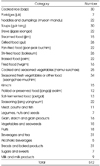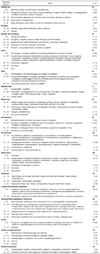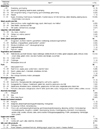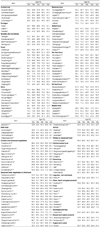Abstract
This study was conducted to investigate which food items are perceived as HANSIK (Korean food) in Korea. 562 males and females aged 20-70 were surveyed on 512 most frequently consumed dish items from 4th Korean National Health and Nutrition Survey if they perceive it as HANSIK. Dish items in kimchi, namul · sukchae (cooked and seasoned vegetable) and jeotgal (salt-fermented food) category showed high response rate to be perceived as HANSIK. The response rate of twigim (frying foods) as HANSIK was low showing less than 70%. The response rate as HANSIK for foreign origin foods such as ramen and jjajangmyeon (black bean paste noodle) were lower than 25%. In jang · yangnyum (seasoning) category, doenjang (soybean paste) and gochujang (red pepper paste) showed high response rate as HANSIK more than 90%. Females showed a higher response rate as HANSIK than males for most food items except several items of myen · mandu (noodle and dumpling). The younger age group had higher HANSIK perception on many items of recently consumed foods, especially budae-jjigae (spicy sausage stew) (p < 0.001) and jwipo-jorim (braised dried filefish) (p < 0.001), implying that they already accept the common foods as HANSIK regardless of the origin. These results provide an information on the foods perceived as HANSIK among currently consumed common foods in Korea and these results can be utilized for establishment of HANSIK concept reflecting transition of dietary life in Korea.
Figures and Tables
Table 1
Category of surveyed common Korean dish items by Korean Health and Nutrition Examination Survey's dishcode scheme

References
1. Baek OH, Kim MY, Lee BH. Menu satisfaction survey for business and industry foodservice workers - focused on food preferences by gender -. Korean J Food Cult. 2007. 22(4):511–519.
2. Chang HJ, Choi BR, Yi NY, Park BS, Kim HS. Preferences and product development opinions of Koreans and Non-Koreans regarding commercialization of Korean foods. Korean J Food Cookery Sci. 2010. 26(4):458–468.
3. Cho MS. A study of intakes of vegetables in Korea. Korean J Food Cult. 2003. 18(6):601–612.
4. Chungangilbo. Cook the world with Korean food. 2011. cited 2012 March 22. Available from http://article.joinsmsn.com/news/article/article.asp?total_id=4938678&cloc=olink|article|default.
5. Chung HK. Korean foods odyssey. 2007. Seoul: Itreebooks;263–267.
6. Chung HK, Kim MH, Kim HR, Chung HJ, Woo N. Developing a healthy Korean food menu through Sikyrochanyo. Korean J Food Nutr. 2011. 24(1):31–53.
7. Hong H, Lee JS. Survey on Korean food preference of college students in Seoul - focused on the staple food and snack -. Korean J Nutr. 2006. 39(7):699–706.
8. Hong H, Kim JY, Lee JS. Survey on Korean food preference of college students in Seoul - focused on side dishes -. Korean J Nutr. 2006. 39(7):707–713.
9. Jung HY, Jeon ER. Preference for Korean food and satisfaction of dormitory foodservice by Chinese students studying at Mokpo National University. J Korean Soc Food Sci Nutr. 2011. 40(2):283–289.
10. Kang IH, Lee KB. Korean dietary custom. 1984. Seoul: Samyoungsa.
11. Kang NE, Chung HK. A study on the sex bias in the nutrition knowledge, food preference and food roles in the family. Korean J Food Nutr. 1992. 5(1):33–40.
12. Kim S, Moon S, Popkin BM. The nutrition transition in South Korea. Am J Clin Nutr. 2000. 71:44–53.
13. Kim SY, Kim JY. Restaurant food choice and preferences of salaried employees in Jinju classified by age and gender. Korean J Nutr. 2002. 35(9):996–1006.
14. Kim KH. A study on the dietary habits, the nutritional knowledge and the consumption patterns of convenience foods of university students in the Gwangju area. Korean J Community Nutr. 2003. 8(2):181–191.
15. Kim JH, Lee JE, Yoon JH, Lim YS, Yoo JY, Jung IK. Perceptions of Korean traditional foods by junior high school students and their parents in Gyoenggi province of Korea. Korean J Community Living Sci. 2008. 19(1):63–74.
16. Korean Food Foundation. Korean food globalization. 2010. cited 2012 April 25. Available from http://www.hansik.org/index.do.
17. Korea Food Research Institute. Development of Korean foods marketing model. 2008. Kyonggi: 56–62.
18. Kwon SY, Yoon SJ. Recognition and preference to Korean traditional food of Chinese at Seoul residence. Korean J Food Cult. 2006. 21(1):17–30.
19. Kwon YJ, Shin BK. The impact of understanding Korean food on image, attitude, and globalization regarding Korean food. Korean J Culinary Res. 2010. 16(2):136–154.
20. Lee JM, Oh SY. Traditional and modern food use in Korean adults in Seoul. Korean J Diet Cult. 1996. 11(2):147–154.
21. Lee YJ, Seo YJ, Joo HS, Hok SK. A study on the satisfaction for the menu quality of Korean traditional food of japanese tourists. Korean J Food Cult. 2005. 20(2):283–291.
22. Lee MA. Global strategy of Korean foods. Food Sci Ind. 2008. 41(4):2–15.
23. Lee EJ, Kim TH, Kim DR. Globalization of Korean cuisine through the Korean food items promotion - focus on marketing strategy of Korean food items -. Korean J Food Cult. 2008. 23(6):729–736.
24. Lee YJ. The effects of Korean food globalization on foreigners' perception of wellbeing value and experience with Korean food. Korean J Food Cult. 2010. 25(5):487–498.
25. Lee KH, Park ES. School food service satisfaction and menu preferences of high school students - focused on Iksan, Cheonbuk -. Korean J Community Nutr. 2010. 15(1):108–123.
26. Lee BS, Park HJ, Jung JW. A study on the difference of perception about traditional food by generations in Busan area. Korean J Culinary Res. 2010. 16(4):1–14.
27. Moneytoday. Glance a possibility of Korean food globalization in Hukuoka, Japan. 2010. cited 2012 March 22. Available from http://mnb.mt.co.kr/mnbview.php?no=2010121414541352521.
28. Ministry of Health and Welfare & Korea Centers for Disease Control and Prevention. 2010 National health statistics - The 5th Korea National Health and Nutrition Examination Survey, the first year 2010. 2011. Korea: Korean Centers for Disease Control and Prevention.
29. Min SH, Park OJ. A survey on the Korean food preference, frequency and nutritional knowledge of college students in Kangwondo area. Korean J Food Cult. 2004. 19(1):43–51.
30. Min KH. Recognition and preference of university students of Korean food in Australia. Korean J Culinary Res. 2010. 16(5):92–102.
31. Park SH, Lee MA, Cha SM, Kwock CK, Yang IS, Kim DH. Analysing foreign consumers perceived brand image of Korean food. Korean J Food Cookery Sci. 2009a. 25(6):655–662.
32. Park MJ, Kim SE, Kim GW. Meal types and preference on Korean traditional foods of university students in Chungnam. J Korean Living Sci Assoc. 2009b. 18(2):491–500.
33. Park SY. Direction of strategy for Korean food globalization. Food Ind. 2010. 215:29–32.
34. Seo KH, Lee SB, Shin MJ. Research on Korean food preference and the improvement of Korean restaurants for Japanese and Chinese students in Korea. Korean J Soc Food Cookery Sci. 2003. 19(6):715–722.
35. Shin DH. It is time to define clearly "Hansik" together in our field. Food Sci Ind. 2010. 43(2):79–82.
36. Yon MY, Han YH, Hyun TS. Dietary habits, food frequency and dietary attitudes by gender and nutrition knowledge level in upper-grade school children. Korean J Community Nutr. 2008. 13(3):307–322.
37. Yoon SS. Korean foods (History and cooking). 1986. Seoul: Suhaksa.
38. Yoon ES, Yoon OH, Chung DR, Shin DJ, Kye SK, Lee MK. Korean cooking. 2003. 3rd eds. Seoul: Hyoilbooks.
39. Yoon HR. The study of dinning-out behavior and preference on Korean foods by age groups. Korean J Food Cult. 2005a. 20(5):608–614.
40. Yoon HR. A study on recognition and preference of Korean foods for foreigners in different nationality. Korean J Food Cult. 2005b. 20(3):367–373.




 PDF
PDF ePub
ePub Citation
Citation Print
Print








 XML Download
XML Download